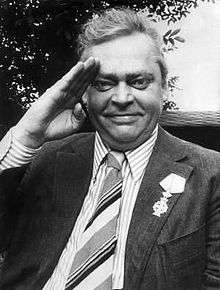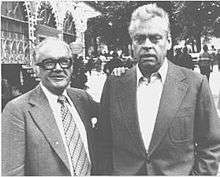Dirch Passer
Dirch Hartvig Passer (18 May 1926 – 3 September 1980) was a celebrated Danish actor. He was greatly renowned for his improvisational skills and, with a filmography comprising 90 movies, one of Denmark's most prolific actors. His life is depicted in the Danish semi-biographical film A Funny Man (2011, Danish title Dirch) directed by Martin Zandvliet.[1]
Dirch Passer | |
|---|---|
 Dirch Passer (1974) | |
| Born | Dirch Hartvig Passer 18 May 1926 Østerbro, Copenhagen, Denmark |
| Died | 3 September 1980 (aged 54) Copenhagen, Denmark |
| Occupation | Actor, comedian |
| Years active | 1947–1980 |
| Spouse(s) | Hanne Bjerre, Sigrid Horne-Rasmussen |
| Partner(s) | Judy Gringer, Bente Askjær |
| Children | Dorte Passer, born August 7, 1951 and Josefine Passer, born January 13, 1966 |
Life
When he was young, Passer was very shy, but had an ambition to become an actor. Instead, he conformed to his father's wishes by attending the J. Lauritzen sea training school near Svendborg in 1944. But since he had persistent problems with seasickness, he later attended the drama school De frederiksbergske teatres Elevskole.
During the 1950s he formed a duo with his colleague and friend Kjeld Petersen.[2] Their revue sketches, based upon the contrast between Petersen’s mixture of joviality and desperate anger and Passer’s deadpan responses, are still considered classics by the public. The sudden death of Kjeld Petersen in 1962 led Passer to avoid revues for five years, but he built up an individual reputation and in 1967 he returned to the revue gaining new victories. Many thin jokes in the scripts were greatly improved by his performance. In particular, his many amiable eccentrics and "nature experts" together with his sketch roles as a baby and as a nonsense "Russian"-speaking clown made him famous. From his later years must be mentioned an almost silent sketch in which he portrays a man’s vain attempt to stop smoking (also shown in West German TV). It was told that he could speak any language, however he wouldn't understand any of it, which was one of his good qualities.
In his life, Dirch Passer wanted to play more serious roles instead of remaining in comedy. However, his image as a comedian was so solid that his attempt to break into serious acting was a failure.[3]
Career
He was often referred to as a loud actor in spite of the fact that under-acting was responsible for much of his force. A Danish critic, Jens Kistrup, once said that one of the secrets behind the comedy of Passer was its combination of elements that are normally regarded as incompatible. He possessed noisiness and discretion, loudness and quietness, boundlessness and complete control, craziness and softness — all this combined with a special intimacy with the audience. Among his inspirations he mentioned Joe E. Brown but he was also known for his admiration of the British comedian Tommy Cooper. In his films, which were of very mixed quality, he often played kind and somewhat crazy "Everymen" or antiheroes. Among his best movie roles were stage roles transferred to film; here must be mentioned the hero in Charley’s Aunt (1959), Celestin-Floridor in Frøken Nitouche (1963) and Leopold in Summer in Tyrol (i.e. The White Horse Inn, 1964).

Numerous Danish actors see him as a role model. In day-to-day life he was quite shy in behaviour, somewhat the opposite of his theatrical appearances. He collapsed just off stage dressed as a clown for the opening number of the season premiere of Tivolirevyen, dying shortly after arrival at the hospital.
Filmography
- Sikken en nat (1947)
- Lykke på rejsen (1947)
- Stjerneskud (1947)
- Den opvakte jomfru (1950)
- Som sendt fra himlen (1951)
- Dorte (1951)
- Vi arme syndere (1952)
- Vejrhanen (1952)
- Rekrut 67, Petersen (1952)
- Drömsemester (1952)
- Ved kongelunden... (1953)
- Solstik (1953)
- Dirch Passer vælter byen (1954)
- Sju svarta be-hå (1954)
- Sol, sommer og badevand (1954)
- I kongens klæ'r (1954)
- Far och flyg (1955)
- Det var paa Rundetaarn (1955)
- Hvad vil De ha'? (1956)
- Den store gavtyv (1956)
- Færgekroen (1956)
- Dirch & Kjeld hos C. & G. (1957)
- Tag til marked i Fjordby (1957)
- Dirch & Kjeld blir nye mennesker (1958)
- Krudt og klunker (1958)
- Styrmand Karlsen (1958)
- Pigen og vandpytten (1958)
- Møde ved midnat (1958)
- TV te' vands (1959)
- Poeten og Lillemor (1959)
- Onkel Bill fra New York (1959)
- Soldaterkammerater rykker ud (1959)
- Charles' tante (1959)
- Vi er allesammen tossede (1959)
- Dyden er ikke dirchefri (1960)
- Poeten og Lillemor og Lotte (1960)
- Elefanter på loftet (1960)
- Baronessen fra benzintanken (1960)
- Sømand i knibe (1960)
- Sommar och syndare (1960)
- Skibet er ladet med (1960)
- Panik i paradis (1960)
- Forelsket i København (1960)
- Reptilicus (1961)
- Peters baby (1961)
- Poeten og Lillemor i forårshumør (1961)
- Støv på hjernen (1961)
- Gøngehøvdingen (1961)
- Lykkens musikanter (1962)
- Han, Hun, Dirch og Dario (1962)
- Det tossede paradis (1962)
- Filmdesorientering (1962)
- Sømænd og svigermødre (1962)
- Det støver stadig (1962)
- Oskar (1962)
- Svinedrengen og prinsessen på ærten (1962)
- Venus fra Vestø (1962)
- Pigen og pressefotografen (1963)
- Vi har det jo dejligt (1963)
- Hvis lille pige er du? (1963)
- Frøken Nitouche (1963)
- Bussen (1963)
- Tre piger i Paris (1963)
- Støv for alle pengene (1963)
- Majorens oppasser (1964)
- Sommer i Tyrol (1964)
- Blåjackor (1964)
- Don Olsen kommer til byen (1964)
- Här kommer bärsärkarna (1965)
- Passer passer piger (1965)
- Flådens friske fyre (1965)
- Pigen og millionæren (1965)
- Jag - en älskare (1966)
- Der var engang (1966)
- Slap af, Frede! (1966)
- Pigen og greven (1966)
- Copenhagen Design (1967)
- Elsk... din næste! (1967)
- Onkel Joakims hemmelighed (1967)
- Cirkusrevyen 67 (1967)
- Nyhavns glade gutter (1967)
- Mig og min lillebror (1967)
- Musikken var af Kai Normann Andersen (1968)
- Soldaterkammerater på bjørnetjeneste (1968)
- Mig og min lillebror og storsmuglerne (1968)
- Min søsters børn vælter byen (1968)
- Dyrlægens plejebørn (1968)
- Sjov i gaden (1969)
- Pigen fra Egborg (1969)
- Mig og min lillebror og Bølle (1969)
- Gyldenblonde fortæller, Den (1970)
- Kyrkoherden (1970)
- Amour (1970)
- Nøglen til paradis (1970)
- Præriens skrappe drenge (1970)
- Hurra for de blå husarer (1970)
- Hvor er liget, Møller? (1971)
- Guld til præriens skrappe drenge (1971)
- Min søsters børn, når de er værst (1971)
- Takt og tone i himmelsengen (1972)
- Lenin, din gavtyv (1972)
- Solstik på badehotellet (1973)
- Mig og mafiaen (1973)
- Mafiaen - det er osse mig! (1974)
- Piger i trøjen (1975)
- Spøgelsestoget (1976)
- Piger i trøjen 2 (1976)
- Alt på et bræt (1977)
- Piger til søs (1977)
- Fængslende feriedage (1978)
References
- imdb.com - A Funny Man
- Jesper Gaarskjær (March 2011). Kjeld & Dirch: Historien om Danmarks største komikerpar. ArtPeople. ISBN 978-87-7108-387-3.
- Tommy Gustafsson (15 May 2015). Nordic Genre Film. Edinburgh University Press. pp. 2–. ISBN 978-0-7486-9319-1.
External links
| Wikimedia Commons has media related to Dirch Passer. |
- Dirch Passer on IMDb
- Who was Dirch Passer? article at Eurochannel